



News
Carbon Collectors
Bubble curtains
Floating wind
Wind statistics
Operational advice
Floating Future
Crabbing
Cover
Image Flying Focus

More info
MARIN is, together with several partners, preparing a submission to the IMO’s Marine Environmental Protection Committee to support further improvement of MEPC.1/Circ.896 and other standards. To freely explore the merits of wind propulsion, favourable areas and ship speeds, please refer to our web app https://blueroute.application.marin.nl/. This web app will be extended in a follow-up WiSP project.
Using these wind statistics, the overall performance can be calculated. Figure 3 shows results for the WASP Ecoliner, with CO2 emissions in g per tonne cargo nautical mile (g /(t*nm)) shown in red for the ship without wind propulsion and blue with wind propulsion. The modelling methods follow MEPC.1/Circ.896, which means they are relatively simple (e.g., no leeway induced resistance or added wave resistance). The results show that new routing using ERA5 data substantially increases savings (55% compared to 42%) when taking 100% of the present (MEPC.1/Circ.896) wind statistics into account, which is included as a reference. However, the savings obtained with 50% of (MEPC.1/Circ.896) wind statistics is still higher - 75% - and this cannot be achieved by carrying out the routing and weighting of routes.
The wind statistics obtained with the WASP Ecoliner were used to also calculate the performance of another case: a Newcastlemax bulk carrier with 4 Flettner 35m rotors. A similar trend in performance can be seen, although the performance with routing and weighting is arguably closer to the 50% approach.

Figure 5: Overall performance of the Newcastlemax bulk carrier.

Figure 4: Overall performance of the WASP Ecoliner.
With this amount of development, good predictions, rules and regulations are increasingly important. Joined by the American Bureau of Shipping (ABS), MARIN started a series of Wind-assisted Ship Propulsion (WiSP) Joint Industry Projects in 2019, which are now about to wrap up their second phase.
One of the most sensitive inputs for wind propulsion is, unsurprisingly, the wind itself. When a ship sails in an unfavourable area, for instance around the equator, then there is not much to be gained by using wind propulsion. On the contrary, sailing in the trade winds or on moderate latitudes provides much more potential.
October 2023, no. 137
Create a MARIN account to stay updated

Report
for wind propulsion
Wind propulsion is steadily gaining traction. With many wind propulsion device makers investing in their production process, the growth is predicted to accelerate even more.
At the start of 2023, there were about 24 commercial ships with wind propulsion, which will double during the year. Most of the ships being equipped with wind propulsion obtain overall fuel and greenhouse gas emission savings of roughly 5% - 15%. But interestingly we are now seeing several projects with serious commitment that are aiming for wind propulsion to deliver the majority of the thrust (on average).
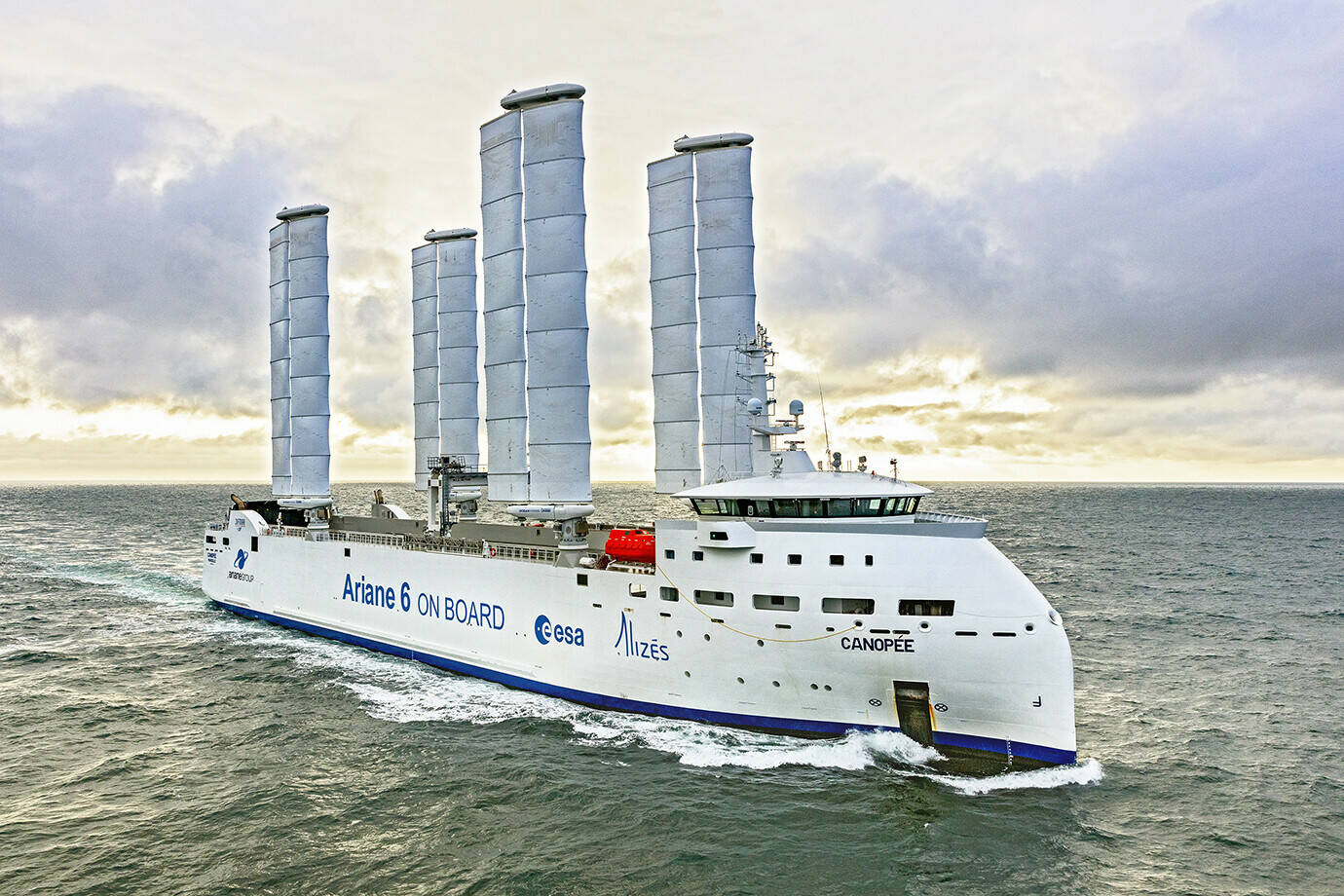
Figure 3. Wind statistics.
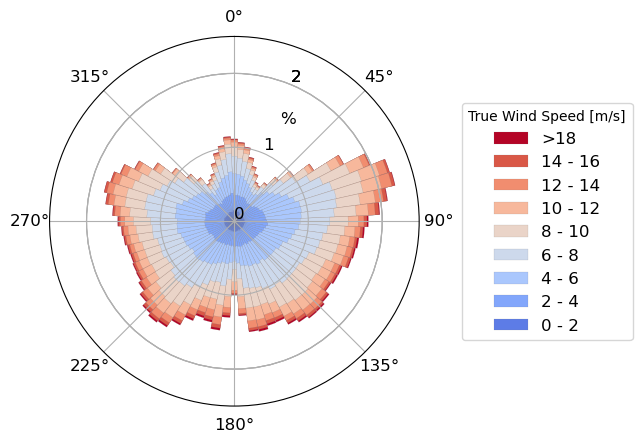

Routing and weighting
The routing provides a substantial benefit as can be seen later. However, a weighting of routes was also performed to favour more beneficial routes over disadvantageous routes, without completely eliminating the latter. For instance, the route from Singapore to Gibraltar, largely around the equator, has on average poor wind statistics and is given a weighting factor of 0.5. On the other hand, the routes crossing the North Atlantic benefit from much better wind (and also have more room for re-routing) and are given a weighting factor of 1.5. Prior to composing the overall statistics, the individual route statistics are multiplied with their weighting factor. The resulting wind statistics shown in Figure 3 demonstrate that the routing and weighting of routes can substantially affect wind statistics. The right figure (with routing and weighting) has significantly reduced head (0 degrees) winds and shows almost no bow quartering winds. The average wind speed also increases from 7.0 to 7.4 m/s.
However, the choice to allow a 50% selection was not based on thorough research. Within WiSP2, MARIN set out to compare newer wind statistics, routing, and weighting of routes for two cases to see how the results compare with just taking the 50% selection.
MARIN first reused the WASP Ecoliner concept (Figure 1), originally developed by Dykstra Naval Architects (but not yet built). Using the so-called “Dynarigs”, the concept yields substantial savings. Voyage simulations, including routing for best wind, were conducted using a global route network with a sailing each month for the period 1999-2019 on each route. Hindcast weather data from ERA5 (by the European Centre for Medium-Range Weather Forecasts) was used. The resulting track plot from all the simulated voyages as shown in Figure 2 indicates that many voyages deviated from the shortest route.
EEDI and EEXI standards
So far, the only open standard that is used to rate ships is the EEDI and EEXI. The standard includes wind statistics that should represent worldwide average conditions. In 2021, the IMO updated the standard mandating that only 50% of the wind conditions with the best wind propulsion must be used. This provides an incentive for wind propulsion as better wind statistics will yield a better overall performance in EEDI and EEXI.To a certain extent such an incentive is appropriate, because:
Ships with wind propulsion will likely not use all global routes at an equal frequency but will prioritise routes with good wind.
Ships with wind propulsion will increasingly be using wind routing to find the best wind on each voyage, especially on the oceans.
The other energy saving methods, outlined under EEDI and EEXI, are also described in ideal conditions (e.g., air lubrication is only assessed in calm water).

Figure 1. WASP Ecoliner.
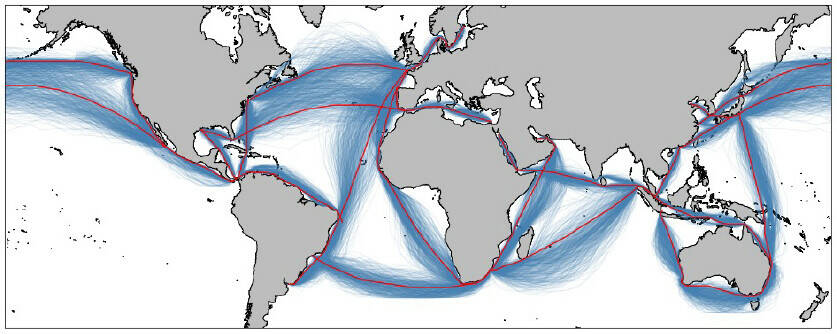
Figure 2. Track plot.




More info

Figure 5: Overall performance of the Newcastlemax bulk carrier.
MARIN is, together with several partners, preparing a submission to the IMO’s Marine Environmental Protection Committee to support further improvement of MEPC.1/Circ.896 and other standards. To freely explore the merits of wind propulsion, favourable areas and ship speeds, please refer to our web app https://blueroute.application.marin.nl/. This web app will be extended in a follow-up WiSP project.
The wind statistics obtained with the WASP Ecoliner were used to also calculate the performance of another case: a Newcastlemax bulk carrier with 4 Flettner 35m rotors. A similar trend in performance can be seen, although the performance with routing and weighting is arguably closer to the 50% approach.

Figure 3. Wind statistics.
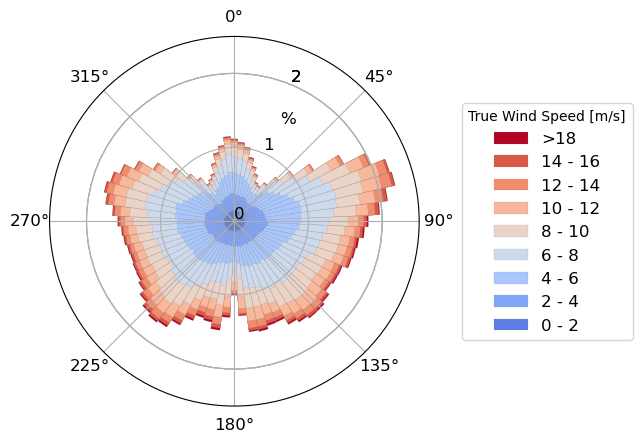

Figure 4: Overall performance of the WASP Ecoliner.
Using these wind statistics, the overall performance can be calculated. Figure 3 shows results for the WASP Ecoliner, with CO2 emissions in g per tonne cargo nautical mile (g /(t*nm)) shown in red for the ship without wind propulsion and blue with wind propulsion. The modelling methods follow MEPC.1/Circ.896, which means they are relatively simple (e.g., no leeway induced resistance or added wave resistance). The results show that new routing using ERA5 data substantially increases savings (55% compared to 42%) when taking 100% of the present (MEPC.1/Circ.896) wind statistics into account, which is included as a reference. However, the savings obtained with 50% of (MEPC.1/Circ.896) wind statistics is still higher - 75% - and this cannot be achieved by carrying out the routing and weighting of routes.
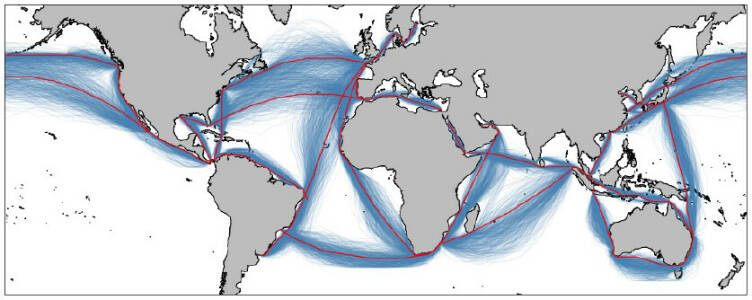
Figure 2. Track plot.
Routing and weighting
The routing provides a substantial benefit as can be seen later. However, a weighting of routes was also performed to favour more beneficial routes over disadvantageous routes, without completely eliminating the latter. For instance, the route from Singapore to Gibraltar, largely around the equator, has on average poor wind statistics and is given a weighting factor of 0.5. On the other hand, the routes crossing the North Atlantic benefit from much better wind (and also have more room for re-routing) and are given a weighting factor of 1.5. Prior to composing the overall statistics, the individual route statistics are multiplied with their weighting factor. The resulting wind statistics shown in Figure 3 demonstrate that the routing and weighting of routes can substantially affect wind statistics. The right figure (with routing and weighting) has significantly reduced head (0 degrees) winds and shows almost no bow quartering winds. The average wind speed also increases from 7.0 to 7.4 m/s.
However, the choice to allow a 50% selection was not based on thorough research. Within WiSP2, MARIN set out to compare newer wind statistics, routing, and weighting of routes for two cases to see how the results compare with just taking the 50% selection.
MARIN first reused the WASP Ecoliner concept (Figure 1), originally developed by Dykstra Naval Architects (but not yet built). Using the so-called “Dynarigs”, the concept yields substantial savings. Voyage simulations, including routing for best wind, were conducted using a global route network with a sailing each month for the period 1999-2019 on each route. Hindcast weather data from ERA5 (by the European Centre for Medium-Range Weather Forecasts) was used. The resulting track plot from all the simulated voyages as shown in Figure 2 indicates that many voyages deviated from the shortest route.
EEDI and EEXI standards
So far, the only open standard that is used to rate ships is the EEDI and EEXI. The standard includes wind statistics that should represent worldwide average conditions. In 2021, the IMO updated the standard mandating that only 50% of the wind conditions with the best wind propulsion must be used. This provides an incentive for wind propulsion as better wind statistics will yield a better overall performance in EEDI and EEXI.To a certain extent such an incentive is appropriate, because:
Ships with wind propulsion will likely not use all global routes at an equal frequency but will prioritise routes with good wind.
Ships with wind propulsion will increasingly be using wind routing to find the best wind on each voyage, especially on the oceans.
The other energy saving methods, outlined under EEDI and EEXI, are also described in ideal conditions (e.g., air lubrication is only assessed in calm water).
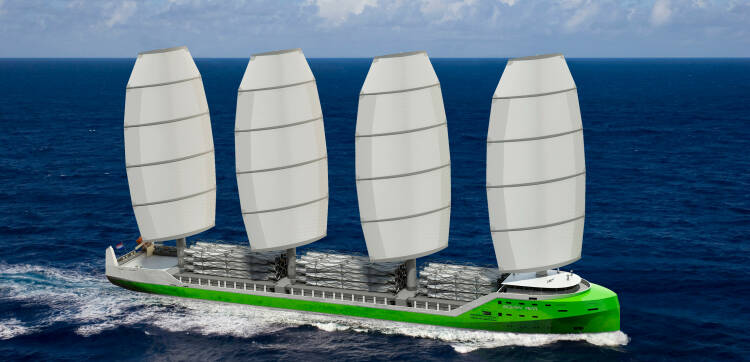
Figure 1. WASP Ecoliner.
With this amount of development, good predictions, rules and regulations are increasingly important. Joined by the American Bureau of Shipping (ABS), MARIN started a series of Wind-assisted Ship Propulsion (WiSP) Joint Industry Projects in 2019, which are now about to wrap up their second phase.
One of the most sensitive inputs for wind propulsion is, unsurprisingly, the wind itself. When a ship sails in an unfavourable area, for instance around the equator, then there is not much to be gained by using wind propulsion. On the contrary, sailing in the trade winds or on moderate latitudes provides much more potential.
At the start of 2023, there were about 24 commercial ships with wind propulsion, which will double during the year. Most of the ships being equipped with wind propulsion obtain overall fuel and greenhouse gas emission savings of roughly 5% - 15%. But interestingly we are now seeing several projects with serious commitment that are aiming for wind propulsion to deliver the majority of the thrust (on average).
Wind propulsion is steadily gaining traction. With many wind propulsion device makers investing in their production process, the growth is predicted to accelerate even more.
for wind propulsion
October2023, no. 137




Report








